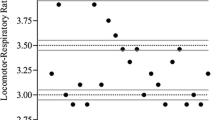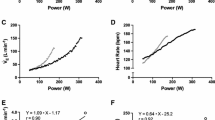Abstract
It was recently observed that inclining the body from a supine to upright position improved the performance of high-intensity, constant-load cycling to a larger extent in men than women (Egaña et al. in Eur J Appl Physiol 96:1–9, 2006), although this gender-related effect was based on a small number of men (n = 5) and women (n = 5). To explore this effect further, we studied the effect of body tilt on cycling performance in a larger and different group of men (n = 8) and women (n = 18). Peak power, peak \({{\dot{V}}\hbox{O}_{2}}\) and the ventilatory threshold (VT) were determined during an upright maximal graded cycle test, and a high-intensity test (80% peak power) was performed to failure in both the upright and supine positions. Performance was significantly longer in the upright compared with supine position in men (17.4 ± 7.7 vs. 7.6 ± 3.4 min) and women (14.1 ± 6.0 vs. 6.0 ± 3.7 min). The magnitude of this postural effect was not significantly different between men and women; whereas it was significantly correlated with the relative intensity of exercise expressed as a function of VT (r = −0.39). These data demonstrate that the postural effect on high-intensity cycling performance is not influenced by gender; but that it is related to the intensity of exercise relative to the ventilatory threshold.



Similar content being viewed by others
References
Barclay JK (1986) A delivery-independent blood flow effect on skeletal muscle fatigue. J Appl Physiol 61:1084–1090
Beaver WL, Wasserman K, Whipp BJ (1986) A new method for detecting anaerobic threshold by gas exchange. J Appl Physiol 60:2020–2027
Convertino VA, Goldwater DJ, Sandler H (1984) Oxygen uptake kinetics of constant-load work: upright vs. supine exercise. Aviat Space Environ Med 55:501–506
Durnin JV, Womersley J (1974) Body fat assessed from total body density and its estimation from skinfold thickness: measurements on 481 men and women aged from 16 to 72 years. Br J Nutr 32:77–97
Egaña M, Green S (2005) Effect of body tilt on calf muscle performance and blood flow in humans. J Appl Physiol 98:2249–2258
Egaña M, Green S (2007) Intensity-dependent effect of body tilt angle on calf muscle fatigue in humans. Eur J Appl Physiol 99:1–9
Egaña M, Green S, Garrigan EJ, Warmington S (2006) Effect of posture on high-intensity constant-load cycling performance in men and women. Eur J Appl Physiol 96:1–9
Fitzpatrick R, Taylor JL, McCloskey DI (1996) Effects of arterial perfusion pressure on force production in working human hand muscles. J Physiol 495 (Pt 3):885–891
Folkow B, Haglund U, Jodal M, Lundgren O (1971) Blood flow in the calf muscle of man during heavy rhythmic exercise. Acta Physiol Scand 81:157–163
Hogan MC, Richardson RS, Kurdak SS (1994) Initial fall in skeletal muscle force development during ischemia is related to oxygen availability. J Appl Physiol 77:2380–2384
Hogan MC, Gladden LB, Grassi B, Stary CM, Samaja M (1998) Bioenergetics of contracting skeletal muscle after partial reduction of blood flow. J Appl Physiol 84:1882–1888
Koga S, Shiojiri T, Shibasaki M, Kondo N, Fukuba Y, Barstow TJ (1999) Kinetics of oxygen uptake during supine and upright heavy exercise. J Appl Physiol 87:253–260
Leyk D, Essfeld D, Hoffmann U, Wunderlich HG, Baum K, Stegemann J (1994) Postural effect on cardiac output, oxygen uptake and lactate during cycle exercise of varying intensity. Eur J Appl Physiol Occup Physiol 68:30–35
MacDonald MJ, Shoemaker JK, Tschakovsky ME, Hughson RL (1998) Alveolar oxygen uptake and femoral artery blood flow dynamics in upright and supine leg exercise in humans. J Appl Physiol 85:1622–1628
Morton RH (2006) The critical power and related whole-body bioenergetic models. Eur J Appl Physiol 96:339–354
Tachi M, Kouzaki M, Kanehisa H, Fukunaga T (2004) The influence of circulatory difference on muscle oxygenation and fatigue during intermittent static dorsiflexion. Eur J Appl Physiol 91:682–688
Wright JR, McCloskey DI, Fitzpatrick RC (1999) Effects of muscle perfusion pressure on fatigue and systemic arterial pressure in human subjects. J Appl Physiol 86:845–851
Author information
Authors and Affiliations
Corresponding author
Rights and permissions
About this article
Cite this article
Egaña, M., Smith, S. & Green, S. Revisiting the effect of posture on high-intensity constant-load cycling performance in men and women. Eur J Appl Physiol 99, 495–501 (2007). https://doi.org/10.1007/s00421-006-0365-8
Accepted:
Published:
Issue Date:
DOI: https://doi.org/10.1007/s00421-006-0365-8




